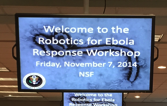 The following is a special contribution to this blog from Computing Community Consortium (CCC) Chair Gregory Hager (Johns Hopkins University).
The following is a special contribution to this blog from Computing Community Consortium (CCC) Chair Gregory Hager (Johns Hopkins University).
Imagine you have to change the IV on a writhing patient while wearing two layers of protective gear, the temperature is nearly 100 degrees, the humidity is 100 percent, and you’ve been in your suit for nearly an hour. That is the daily struggle for healthcare workers across Western Africa treating Ebola patients.
Can we somehow use our technologies, either those existing today or envisioned for the near future, to change the course of this daily battle and, by doing so, have an impact that could potentially save the lives of thousands of individuals?
In a collection of workshops hosted at Texas A&M, UC Berkeley, Worcester Polytechnic and in Washington DC, researchers from several universities, agencies, and care organizations came together to discuss ways that technology might contribute to the detection and treatment of victims of Ebola, and how the lessons learned could help to prepare for the possibility of future pandemics.
The workshops shared a set of presentations by healthcare workers familiar with the conditions in West Africa, with a particular focus on the challenges of providing care while ensuring the safety of the hundreds of volunteers caring for victims of Ebola. From these presentations, several issues emerged such as safe donning and doffing of sterile garb by overheated and exhausted workers; the gathering and disposal of hazardous waste; cleaning and sterilization of beds, equipment, and belongings. Surrounding problems included the lack of infrastructure, intermittent power, unsterile conditions, and the overarching requirement for simple-to-use, low-cost solutions. A few of the ideas that emerged included:
- Developing remote presence capabilities that would reduce the number of workers and/or time on the “hot zone.”
- Creating “human augmentation systems” by equipping low-skill workers with cameras and microphones so that they could perform some of the duties under the instruction of a supervisor, thus “force multiplying” available doctors and nurses.
- Creating data collection systems that would provide detailed documentation of current activities that can be made available to the research community for future analysis and research.
As a participant, what was perhaps most exciting to me about the workshop was the range of experience and background around the table, and the palpable desire to find realistic and actionable solutions. Conversations ranged from new ideas for deformable grippers for handling fragile lab material, to new ways to isolate patients so that basic care activities were simpler and easier, to the latest technology for robotic phlebotomy, to ways to monitor activities and detect errors that might lead to contamination or infection.
Anyone in the community interested in these problems should consider responding to the Dear Colleague Letter by NSF Director Dr. France Córdova that will make funds available for immediate solutions addressing these and other issues related to the current Ebola crisis, or to contribute ideas to the USAID Ebola Grand Challenge site.









